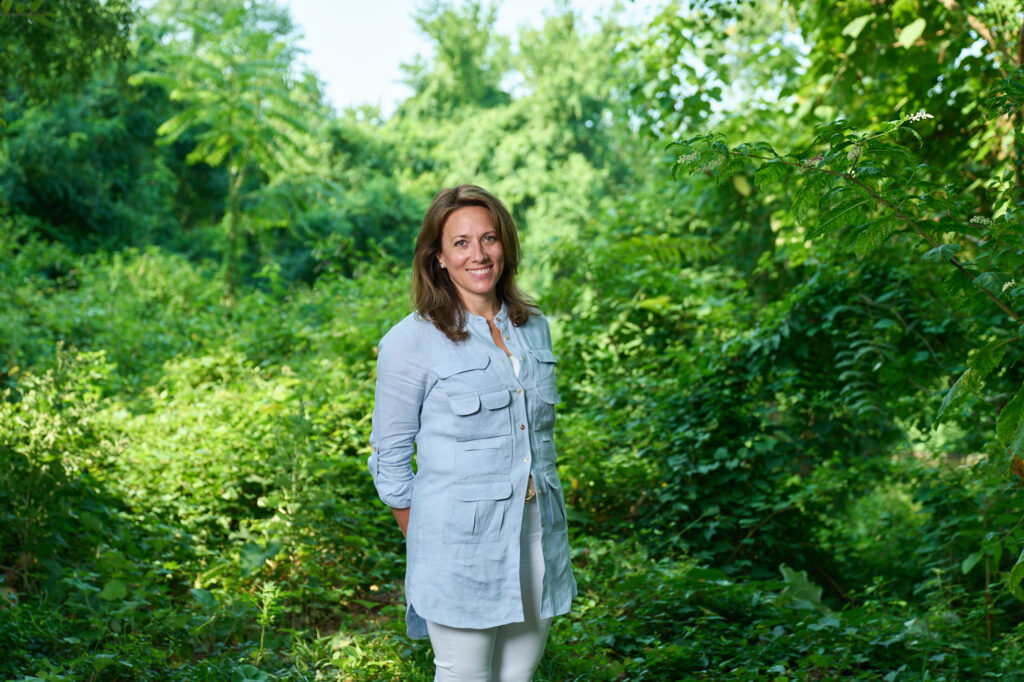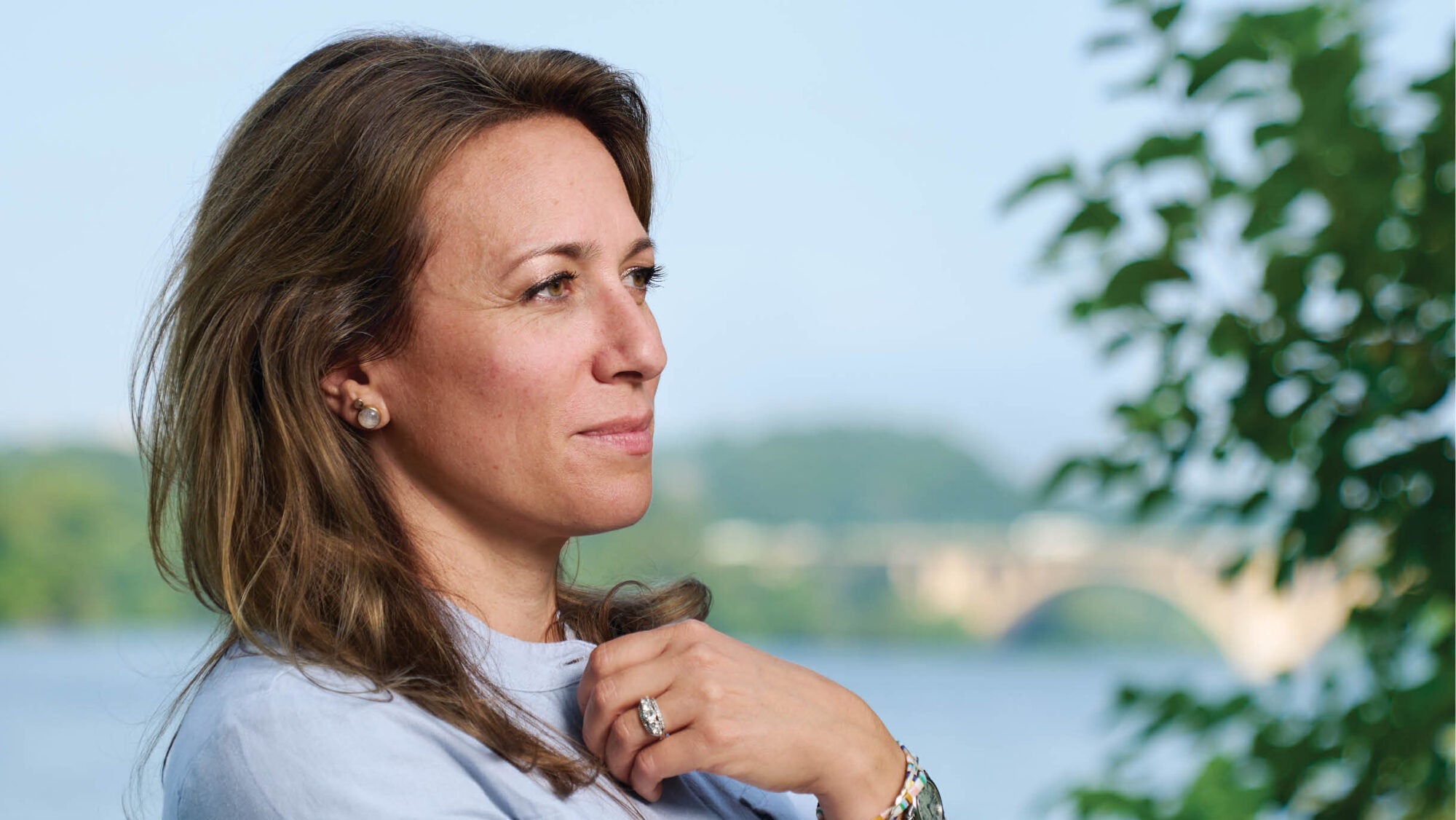It’s Not All Lost — Carrying Forward 70 Years of Conservation Research and Hope
It’s July 14—and it’s World Chimpanzee Day. Maybe you weren’t aware of this monumental day, but July 14 is a very big deal to Anna Rathmann (EMBA’21), who today is sitting in her home office outside of Washington, D.C., in front of a black and white image of African elephants captured by her colleague at National Geographic, where she spent a decade of her career.
“On July 14, 1960, a young Dr. Jane Goodall stepped off of the boat of Lake Tanganyika and stepped onto the shores of what would become Gombe Stream National Park,” says Rathmann. “It is the day she began her seminal research.”
For Rathmann, the executive director of the Jane Goodall Institute (JGI) USA, July 14 marks the day it all began for the organization she now leads.
From that day in 1960 the work of Dr. Jane Goodall, DBE, founder of he Jane Goodall Institute, and a UN Messenger of Peace, hasn’t stopped. And though her name is synonymous with conservation, chimpanzees, and their range across countries in Africa, this was never a one-woman show.
“The reason the Institute was initially founded in 1977 was because Jane wanted to have continuous study,” says Rathmann. “She didn’t want to have to rely upon funding cycles of various grants. And so she wanted to start doing her own fundraising that could ensure that research continued.”
From Goodall’s initial research, the Institute—now through Gombe Stream Research Center—has studied chimpanzees and their roles and personalities in the ecosystem. This work led by JGI is now the longest running wild chimpanzee research in the world—verified by Guiness World Records. But what started as an effort to support research pivoted to a lifelong commitment to creating a better world. In 1980 Goodall left the forest a scientist, and became an activist. Today, JGI focuses on a holistic approach to conservation—known as “community-led conservation” something that was completely innovative at the time and is now considered a best-in-class approach to meaningful conservation change.
What Goodall first created in the early ’90s was known as The Lake Tanganyika Catchment Reforestation and Education (TACARE) program. TACARE was designed as a pilot project to protect chimpanzees outside National Parks by addressing poverty and supporting sustainable livelihoods in villages around Lake Tanganyika. Now known as Tacare, it represents JGI’s community- led conservation approach. The Tacare philosophy is based on the principle that local people are the most connected to and dependent on healthy landscapes and ecosystem services. Tacare also acknowledges that though local people are the most impacted and vulnerable when ecosystem services disappear, they are also the best stewards of their own environment, and that every community member can make a difference every day. Beyond just collaboration, Tacare is about local ownership of the process of human development and managing local environments.
Today, Tacare builds solutions with partnership with local people focused on addressing the drivers of threats. Through this process, JGI has created scholarships for young women to stay in school. It has built micro-credits so individuals—women especially—can create and support their own small sustainable businesses and build environmentally conscious communities. It has funded beekeeping and honey production initiatives to provide alternative livelihood options. It has also focused on ending issues like the illegal wildlife trade and rehabilitated and released animals back into the wild, especially in the Republic of the Congo. It is work Goodall started—and work Anna Rathmann will continue just as Jane Goodall had planned. “So, Happy World Chimpanzee Day!” Rathmann says with a smile.
Rathmann, like most young women interested in conservation, remembers seeing Jane Goodall in images growing up. Goodall with her binoculars observing our closest living relatives. Goodall proclaiming to the world that these animals were capable of emotions, as well as capable of making and using tools—something no other western researcher had noted until this woman, with her famous khaki clothing and ponytail, came along. Until that time, humans were considered worlds beyond the rest of the animal kingdom when it came to emotional and intellectual intelligence, and Goodall had an uphill battle to prove herself against the broader scientific community. In fact, she had an uphill battle as a woman in science overall as government officials refused to allow Goodall to travel to Tanzania alone and insisted she bring a companion. She chose another woman to accompany her: her mother. “That was the world in which she was walking into, literally, when she went into the forest in Tanzania,” says Rathmann. “The fact that she was able to—through her observations and her continued research—change that perception in such a monumental way to where the scientific community was now acknowledging that yes, non-human animals, like humans, have emotion, and other great apes, like humans, use tools. Suddenly the lines were blurred between humans and the rest of the animal kingdom. That is an extraordinary contribution to our global understanding of our own species.” More extraordinary, perhaps, was the fact that Goodall had no college education or scientific training—just passion, patience, and an immense curiosity.
You see the beauty of a place; you see how special it is. You see the interconnectivity of everything in the natural world, and you can’t help but want to protect that. I wanted to protect it and share it with people in a way that they could also see the magic of it.
And, for Rathmann, there was a great deal of magic in the United States and across countries in Africa. While earning a B.A. from Valparaiso University in Indiana, she worked as a seasonal park ranger with the National Park Service in Yellowstone, where she learned quickly that conservation is a much more complicated matter than cleaning up after yourself on a hike. “That job really impressed upon me the complexity of conservation—managing different stakeholders; resource management and what that looks like; the difference between preservation and conservation.” Yellowstone also taught her what it meant to be a representative of something much larger than yourself.
The knowledge gained in Yellowstone took her to the National Geographic Society, where she honed her skills in fundraising initiatives and programming for over a decade. Not only that, but the role expanded her vision beyond the states. “National Geographic took me into a space where I could see what conservation looked like on an international scale and the ways other countries approached it, specifically across countries in Africa.” From National Geographic, Rathmann moved on to become the inaugural director of the Great Plains Conservation Foundation, where she established and implemented sustainable wildlife, land, and community conservation initiatives throughout Kenya, Zimbabwe, and Botswana.
Her knowledge of countries in Africa—a continent she visits several times a year—led her to JGI USA, an organization that from day one, sought new knowledge with the full understanding that the world of conservation must evolve to fit more in line with what Goodall has always observed – people, other animals, and our environment are interconnected.
In Goodall’s early conservation days, much of that knowledge creation revolved around observational research and opening the eyes of the scientific community not only to the minds of animals like chimpanzees, but the challenges they faced in threatened environments. Today, JGI has a team of field researchers, including many local Tanzanians, who are schooled in such work, but she also has new tools at her disposal. Rathmann looks to the long-term partnerships JGI has had with tech firms to study the world around them with little disruption. Bioacoustics, for example, are a growing part of JGI’s work and is just a technical term for placing microphones throughout the forest ecosystem to track different species through computer algorithms that help identify sounds. That’s not possible, notes Rathmann, without big data, which is influencing every organization and industry, including the nonprofit world of conservation. Perhaps tech doesn’t seem to fit in the natural world of Tanzania or Yellowstone, but Goodall and Rathmann and the rest of JGI know it allows for huge steps forward. “We often talk amongst the team about how Jane was a disruptor,” says Rathmann. “She’s the original disruptor, so it doesn’t surprise any of us that she is drawn to whatever tools will help create new knowledge.”
While tech will certainly influence the way the JGI moves forward, Rathmann also knows that its future really lies where it always has—in communities.
As discussed above, Goodall and JGI have always put people at the center of conservation. “African countries still have in its landscapes major apex predators. That’s a big difference to the United States and in Europe as many of those were removed or moved to the fringes and aren’t necessarily part of the day-today experience communities.” Across the continent of Africa, however, a pride of lions could take out a family’s livelihood in one night by dissipating a herd of cattle—and conservation quickly becomes protection of the pride, the cattle, and the family’s finances.”

Anna Rathmann (EMBA’21)
“There is huge value and importance in engaging communities in identifying the problem and creating the solution,” says Rathmann speaking about JGI’s Tacare community-led conservation approach. “There’s an analogy that I saw recently, which really resonates: protecting just a species is akin to trying to save a fish and draining the pond. It doesn’t really work. You need to make sure that that pond is a healthy ecosystem, and that holds true throughout countries in Africa. It holds true universally.” Conservation is really about protecting ecosystems—including people and their needs. That involves commercial interests. That involves the balance between consumptive and non-consumptive use of landscapes and finding the middle ground with people who have differing opinions.
As executive director of JGI USA, Rathmann will continue to have those complicated conversations in the governments of African countries—which for JGI’s programmatic work includes Tanzania, Uganda, Democratic Republic of Congo, Republic of Congo, and several others—and at home in D.C., and she will continue the successful programs put in place by those before her—programs that put community members at the heart of the conversations. Particularly, she says, young people, and points to JGI’s Roots & Shoots program which empowers youth in communities to build projects that can change their communities all of over the world to improve well-being for people, other animals, and the environment— from protecting Michigan’s endangered birds to collecting compost materials to hydroponic classroom gardens. The program which started on Goodall’s front porch in Tanzania has inspired millions to participate and is in all 50 states and over 65 countries worldwide.
Rathmann’s biggest goal though is perhaps less concrete—and goes beyond the numbers of endangered species brought back from the brink of extinction and programs instituted. It is to embrace and proclaim a concept at JGI’s core. At a time when conservation sometimes feels like a losing battle as we contend with climate change, shifting and suffering ecosystems, and unsustainable consumption and corporate interests, the teams at JGI always comes back to the idea of hope. “It’s not all lost. The ingenuity of humanity, working together, and the idea that challenges are put forth to be met—that narrative runs through the work of JGI.” To Rathmann, hope is critical. It’s easy to believe, says Rathmann, that one person’s actions can make little difference. But she wholeheartedly disagrees.
After all, look what was accomplished by one young woman with no higher education, accompanied by her mother to study our closest living relatives in Tanzania. Though Goodall lived through many barriers—and barriers have only shifted slightly today coupled with other inequities and challenges—Goodall often shares the advice of her mother Vanne who accompanied her on her very first trip into the wonderful world of wild chimpanzees: Work very hard, take advantage of every opportunity, and never give up.
This story was originally featured in the Georgetown Business Fall 2023 Magazine.
